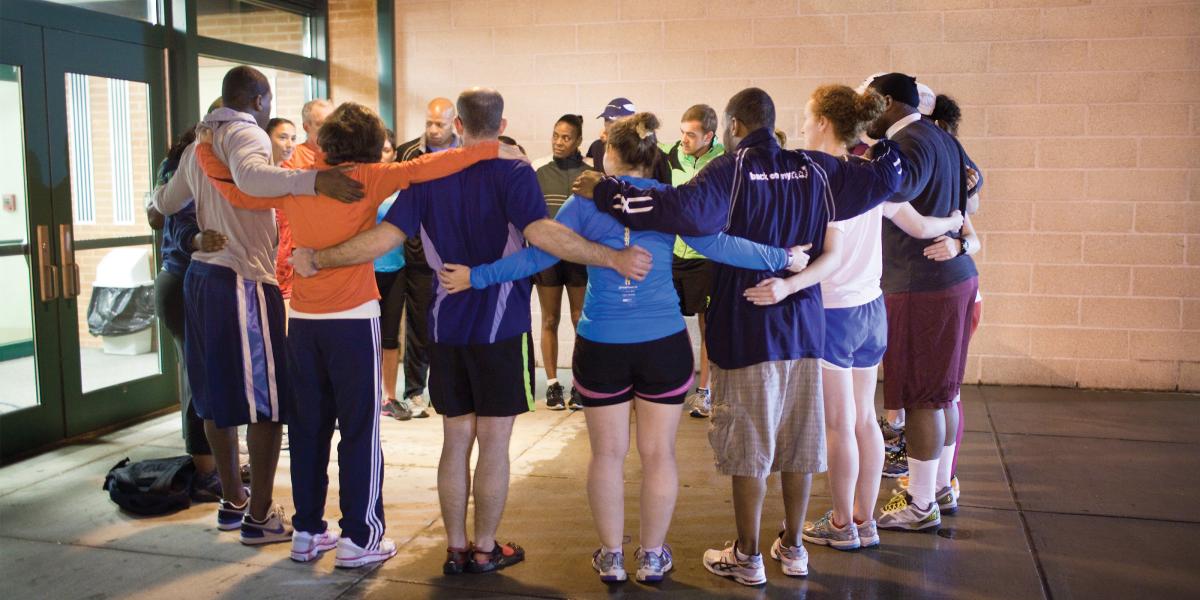A Running Start
It’s quiet and dark in front of Christopher Place Employment Academy. The residential and educational program for homeless men sits between the imposing Baltimore City Jail and Scores strip club.
People in workout clothes trickle into the parking lot from the streets, and men in tracksuits emerge from Christopher Place’s brightly lit lobby.
By 5:30 a.m., two dozen people have exchanged hugs and formed a circle that’s chatty, cheerful and loud, despite the chill and the grim surroundings. They’re a mix of professionals, the unemployed, the recently homeless, graduate students and those in recovery from substance abuse.
After some announcements—Jerome got a second job, David got into medical school—the group circles arms, says the Serenity Prayer and takes off running.
Similar scenes play out in eight other cities across the U.S. several mornings each week as runners of all levels from disparate backgrounds come together through Back on My Feet (BoMF), a nonprofit that uses running as a means to build self-confidence, discipline and, most importantly, a community and support network among the homeless and other underserved populations.
“A lot of these guys haven’t felt the sense of belonging or had expectations on them to commit to something,” says Jaclyn Truncellito, a longtime runner, Bloomberg School MPH student and director of communications and corporate relations for BoMF’s Baltimore chapter.
Truncellito’s faculty advisor at the School, Kevin Frick, PhD, a professor in Health Policy and Management, runs with the Christopher Place group as one of its 60 active volunteer or nonresident members. “These guys just really want to get control of their lives, and the training and consistent goal-setting gives them a sense of control they may have never had before” he says.
George Johnson, 38, who came to Christopher Place in August 2011 after completing an alcoholism rehabilitation program, originally joined BoMF to lose weight, but found that shedding pounds wasn’t the only payoff. “I instantly loved the energy, the camaraderie,” says Johnson, who plans to apply for a BoMF grant to buy a laptop when he goes back to school, and hopes to become an X-ray technician.
Johnson, who is training for a half marathon, says that his running progress and support from his team members help him to weather the “frustrations and stresses” of job hunting.
Back on My Feet offers additional services to members with 30 days’ active participation and a 90 percent attendance record. The Next Steps phase provides help with acquiring job skills training, writing resumes, enrolling in school, preparing for job interviews and a grant of up to $1,250 to aid in the transition to independence. It might pay for tuition, a computer or a security deposit.
Dean Michael Harrod, who stayed in a homeless shelter before coming to Christopher Place, has a decade of experience working on cars and trucks, and hopes to become certified as a diesel mechanic. The soft- spoken team captain says that running with the team helps to build his self-confidence and discipline—and, it’s fun.
“It’s like a party once you get out there,” Harrod says.
Based on BoMF surveys, the program is a success across its chapters, in terms of improvements in self-esteem, setting goals, trusting others and other subjective assessments.
However, from a public health perspective, says Frick, such attitudinal surveys aren’t especially useful because they don’t measure long-term program outcomes. BoMF recently hired an internal evaluator to enhance the process. A fundamental question is whether BoMF members achieve better outcomes—more success finding employment and housing and furthering their education—than individuals who don’t take part in the program.
“I think an organization like this may be able to demonstrate a whole new way of thinking about integrating people into the community,” says Frick.
